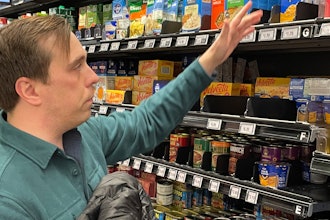
From the trials and tribulations of grocery store trips and delivery delays, to the ever-changing efforts of restaurants to open, to a budding nation of want-to-be bakers, thousands of brands that make up the U.S. food industry continue to face difficult marketing challenges as consumer habits dramatically change amid the stay-at-home or social distancing economy.
At Influence Central, we surveyed 630 consumers in May as part of our effort to understand the consumer mindset during COVID-19, and to provide valuable insights to brand marketers nationwide. Since the start of stay-at-home orders and the pandemic news frenzy, food has been a frequent, varied topic of conversation.
GROCERY SHOPPING, A SPEED EXERCISE IN ANXIETY
 iStock
iStock
- 72% of consumers have lessened the frequency of their grocery shopping during COVID-19.
- Assuming comparable costs, consumers overwhelmingly prefer shopping online with home delivery as their first choice, and drive by or curbside pickup as their second choice.
- 56% of consumers feel anxious about forgetting to pick up or not being able to find specific foods when shopping in-store. A lack of the ability to “swing by” the store for a missing ingredient can change a mealtime game plan.
These trends give grocery stores and the brands that sell through them a chance to convert more shoppers to online grocery for home delivery or grocery pick-up, a trend that’s been on the rise in recent years and exponentially accelerated with the coronavirus onset. Not to mention, it becomes more important than ever to catch the eyes of fickle consumers while they’re in-store, because it might be awhile before they return!
CHANGES IN FAMILY EATING AND SNACKING HABITS
More than half of families’ eating habits have changed in the time they’ve been staying at home. 70% of consumers share that they snack and eat more frequently. No wonder there’s talk circulating about the “COVID 19,” as in the 19 pounds many feel they have gained while isolated at home: snacking or drinking more, and not able to get to the gym. People tend to eat more to cope with stress or boredom, and right now, people find an abundance of both on their hands.
- On the healthier side, 43% eat more fruit and 42% eat more vegetables, and 30% are eating more protein in the form of meat, poultry or fish.
- On the less healthy side, 47% are turning to more sweets, 24% have decreased their vegetable intake, 21% east less fruit and 19% are eating less protein.
- 39%, with more time in the morning, find themselves eating a more filling or balanced breakfast – often considered the most important, and possibly most undervalued, meal of the day.
As eating habits change within households, so do the generalizations many brands use as the tentpoles of their targeted consumer profiles and marketing strategy. A family that once focused on well-rounded meals may find itself sneaking snacks from the pantry; while a family that once relied on quick meals on-the-go may be experimenting with new, homecooked recipes. Marketing will be in constant evolution throughout the upcoming year as consumers decide which habits to keep, and which return to the “old normal.”
 iStock
iStock
COOKING UP A STORM AT HOME
With gatherings and events being cancelled and a resulting surplus of free time for many, people are latching onto cooking as a bastion within which they can shelter themselves from the havoc being wrought by the storm that is COVID-19. Being stuck at home lends itself to a rise in home-cooked meals and recipe experimentation for many. Making dinner for one’s family is much less of a hassle when you’re not facing the delays of rush hour. Not to mention, if you’re not going to be leaving the house anyway, drumming up that motivation to go pick up some takeout is not as easy as it once sounded. We’re all facing new financial fears that sway us away from spending unnecessarily, so using that rice and beans that has been lingering in our pantries since the dawn of time suddenly holds quite a bit more appeal than it once did.
- 88% of people have been cooking more meals at home since stay-at-home orders went into effect.
- 49% are now cooking meals from scratch.
- Another 46% add into the mix pre-cooked and packaged foods.
- Only 5% stick mostly to pre-cooked and packaged options.
- These choices reflect consumer preference (57%) versus availability (43%).
- 84% of consumers eat the meals they prepare right away. 14% share that they instead prefer preparing meals ahead of time and reheating later in the week.
- When it comes to delegating responsibility for meals, 17% are now dividing and conquering meal responsibilities with spouses and partners more often. And for 3%, these responsibilities have entirely reversed. The remaining 80% have kept the roles consistent.
- Organics, while always an upscale option especially in vegetables, fruits and milk products, have become a skippable luxury for those facing tight budgets.
- 67% have been forced to get creative with what’s left in their freezer and pantry between grocery orders or shopping.
- 57% of consumers have undertaken the task of reorganizing their pantries and food storage.
Baking soda, flour, and sugar haven’t had a moment like this since the turn of the new millennium. Pantry and freezer staples are a hot commodity, because as the old adage that sports fans so often use goes, the best ability is availability. Right now, consumers want to cut down on their trips to the grocery store, so anything that they can store outside of jam-packed (no food pun intended!) freezers has instant appeal, the likes of which these brands have not known in the past couple decades.
GOT A NEW RECIPE FOR ME TO TRY?
Upping our home cooking, from trying new recipes or techniques, holds the promise of that mythical “productive activity” that we yearn to invest our time in but has a much more immediate pay-off than say, learning a language, and not nearly as much of a time commitment.
And there has never been a better occasion to climb down the bottomless social media rabbit hole of recipes. More meals being cooked consequently leads to a faster consumption of recipes, with many consumers looking to combat cabin fever and a Groundhog Day-esque fatigue. Heck, right now, people aren’t even afraid to take on those daunting recipes we’ve long dreamed of attempting, once believed to be beyond our culinary capabilities.
- 54% of consumers are trying new or more intricate recipes in their home cooking.
- To do so, 58% look for inspiration online via food and lifestyle influencers as well as cooking apps and websites.
- Out of the consumers using social media as a source for recipes, 42% go to Facebook, 37% turn to food blog posts and 24% go to Instagram.
The food brands that will lose out on this cooking craze will be the ones that are not included in the conversation, because they’re staying silent. Consumers are salivating as much for an activity that will break up the monotony of the day as they are for the food they’re preparing. Whether through video, written recipes, or audiobooks, the format exists for every aspiring chef to channel their inner Gordon Ramsey. The important thing for food brands will be to make themselves visible. The call of duty has been sounded for marketers to release the big PAUSE button on marketing and serve up some great inspiration.
 iStock
iStock
TIME SPENT COOKING
We can’t all be expected to don our chef’s aprons at the drop of a puffy, white hat, though. For those consumers who can’t be bothered to spend an hour in front of a hot oven tending to multiple pots and pans at once, they’re turning to other cook-at-home options. This may take the form of quick recipes with a worthwhile payoff, or it may be simplified to heat-and-eat meals that don’t demand us to lift a finger. Those freezers are full for a reason, after all – many consumers prefer quick and easy!
- When it comes to how long they’re willing to spend preparing dinner, the need for speed still rules the day for most.
- 46% are willing to spend 15 to 30 minutes cooking, while another 44% will spend 30-60 minutes.
- With more time at home, 23% are willing to devote more time to dinner prep, while 73% share that this amount of time has stayed about the same as prior to the stay-at-home order.
For those reluctant cooks, in an age where take-out even from fast food restaurants has diminished, frozen meals from pizzas to more substantial heat and serve entrees, prepared meals ready to cook from the supermarket, and canned goods such as soups and chili become go-to items. It’s clear that even with more time at home, some people still don’t necessarily want to spend all day in the kitchen. Working from home, homeschooling, and keeping up with household chores, doesn’t necessarily allow people more disposable time, despite being in their homes for longer stretches.
Paying close attention to the sources and platforms consumers are utilizing to meal plan, the types of recipes they’re gravitating toward and the immediacy of their eating habits, will impact how brands market to them.
For those consumers for whom the greatest kitchen utility is the microwave, they’re relishing the availability of comfort food staples to get them through this confusion. They may not want to spend a day laboring away in the kitchen for their meals but yearn for quality options in the frozen food aisle that stand above the rest. If a brand can provide this as consumers discover new favorites, they’ll always make the cut in the battle for space in an increasingly crowded freezer.
CALLING ALL KITCHEN GADGETS
Kitchen devices seen a resurgence during this stay-at-home period. While it may be deemed the most valuable according to the consumers we surveyed, not far behind it are similar low-effort options including toasters, coffeemakers, and slow-cookers. For the newly born bakers and baristas among us, cake pans, blenders, and hand mixers are experiencing a similar renaissance.
- With consumers spending more time cooking and baking, many have already purchased or plan on purchasing new small kitchen appliances.
- Leading the purchase wish list: cake pans, multi-cookers/Instant Pot, stand or hand mixers and a new coffee maker.
- Valuable kitchen assets during this time include microwaves (96%), toasters (83%), coffeemakers (81%), slow-cookers (79%), cake pans (74%), blenders (68%) and stand or hand mixers (62%).
A TAKE-OUT SHAKE-OUT
 iStock
iStock
- 69% of consumers have ordered take out or delivery food from restaurants during the pandemic.
- 71% order from restaurants they used to dine-in at prior to the crisis.
- 87% order take-out from a specific local restaurant out of a desire to support the restaurant financially.
- When it comes to getting food delivered, consumers’ top choice is direct from the restaurant itself (60%). Favorite delivery services: Door Dash, followed by GrubHub and Uber Eats. More than half said they have not been concerned to leave the house to pick up food or collect it from a delivery driver.
- Top choices for restaurant types for take-out:
- Pizza (79%)
- Fast Food (52%)
- American and Pub Food (ex. Burgers and wings) (45%)
- Mexican (39%)
- Asian (35%)
- Italian other than Pizza (23%)
As consumers weary of “What’s for dinner?!” endless days in a row, many take-out restaurants have started getting creative, marketing home meal kits, such as a dinner kit from Shake Shack (each kit has eight burger patties, eight buns, eight slices of American cheese and Shake Shack's signature sauce). Chick-fil-A made a similar move, with a chicken parmesan meal kit that can be served in 30 minutes, and includes chicken fillets, marinara sauce, cheese, and creamy lemon garlic pasta. These meal kits help the restaurants move unused food inventory, while blurring the lines between fast casual take-out and grocery ready-to-cook meals. Along these lines, Denny’s has opened Denny’s Market, offering grocery staples such as meats, cheese, eggs and toilet paper for free delivery. Local restaurants have followed this same trend - using their access to great food to sell these items to their customers.
- When it comes to what people most miss about dining in restaurants, they miss most:
- Not having to cook and serve the meal: 64%
- The social aspect of meeting friends and family: 61%
- Trying new dishes and foods: 44%
- Being able to eat a variety of different dishes: 29%
- Access to specialty cocktails and drinks: 22%
These trends are promising for brands in the restaurant and food-service industry. Marketers can appeal to the sentimental side, as people recognize there’s an owner, or person, behind their favorite restaurant. Despite having to battle with lingering safety concerns and disconcerting recommendations around re-opening, the inherent craving for that social setting will allow restaurants to regain momentum despite the current increase in home-cooking.
CHEERS TO THE QUARANTINI
Alcohol has always been a part of restaurant profitability and social culture in the U.S. With varied rules around alcohol sales and delivery state-to-state, alcohol brands have found themselves in an interesting spot. Some creative brands like Grey Goose, have hired out-of-work bartenders to become online mixologists for home-drinking cocktail makers.
- Only 26% of consumers share that they’re consuming even more alcoholic beverages at home now than they were before. But drinks abound even if at typical consumption levels.
- Among all consumers when it comes to drinking choices, wine tops the list of drink choices, with cocktails and beer rounding up the top three:
- 43% turn to red wine
- 38% prefer white wine
- 37% are mixing up cocktails, while 18% prefer hard alcohol straight up or on the rocks.
- 31% drink beer
- 14% love hard seltzer
- 13% like hard cider
- 94% have not utilized any of the home delivery services for alcoholic beverages yet and are still going in-store for their alcohol purchases.
- Of those who are utilizing home delivery services for alcoholic beverages, 65% have only just recently started turning to these services.
Marketers of alcohol brands and services should be pouring themselves into these findings and capitalizing on a market that hasn’t quite taken off. The momentum of Online Grocery Pick-up can be an example to both national alcohol brands, as well as local businesses, including the rapidly growing craft beer industry.
A HIGHLY CAFFEINATED HOME-BREWED NATION
 iStock
iStock
- 89% of consumers have at least one person in their household who now drinks coffee at home.
- 56% brew more pots and cups of coffee at home than before social distancing, generally brewing 2 or more times each day.
- When asked what they are using to brew coffee, 66% purchase ground coffee, 49% use K-Cups and 20% grind coffee beans.
- Among the different types of coffee brands being purchased for home:
- 50% opt for well-known chain coffee shop brands (such as Starbucks, Dunkin Donuts and Caribou).
- 46% preferring well-known grocery store brands (such as Folgers or Maxwell House).
- 29% choose other specialty coffee brands.
- 24% opt for generic supermarket house brand.
- 42% had typically brewed coffee at the office prior to the shift to stay-at-home.
- 71% purchase creamers or other additives specifically for coffee.
People clearly still want their daily pick-me-ups of caffeine during the pandemic, creating a swath of opportunities for coffee brands and coffee appliances alike. Plus, it’s opened the door to new coffee drinks, such as the hugely popular and trending “Dalgona” whipped coffee made with instant coffee whipped with sugar and water, then poured over milk. Clearly, home baristas have arrived!
WHICH TRENDS WILL STICK?
With all these dramatic changes on the food front for consumers, the huge question becomes which of these trends will stick or even accelerate, especially given what may prove an extended period of intermittent social distancing. And for the younger digital generations, relying on large footprints of supermarkets may become a thing of the past.
Stacy DeBroff is a Social and digital media strategist, best-selling author, attorney, and founder and CEO of Influence Central, which delivers cutting-edge social media and digital campaigns focused on influencer marketing






















